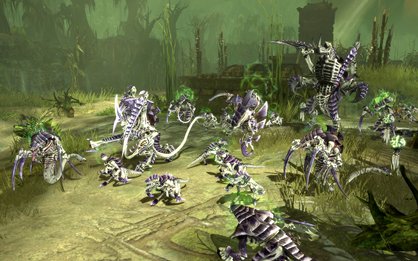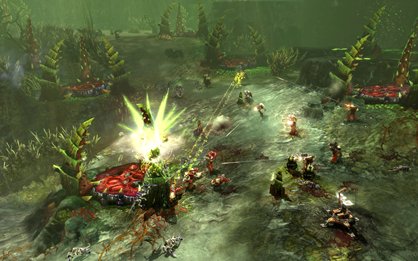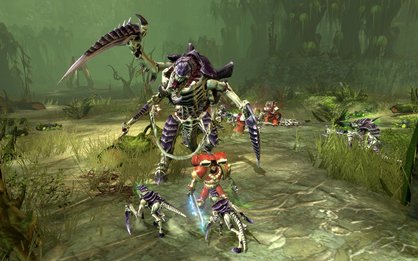The Tyranids have landed
We face Dawn of War II’s most fearsome faction yet
We didn’t spot any other explicit instances of Tyranids being boosted by a larger unit, but the dynamic aspects of the environment seemed just as significant. Almost every segment of the brush was destructible, and cover seemed to directly affect visual detection and combat accuracy alike. Craters formed by explosives can even be used for impromptu cover.

Pushing forward, we’re nearing our main objective: a toxin pool we’re borrowing a biosample from for study. Leapfrogging through cover cushions, our units never feel lost and rarely bunch up in a grenade-friendly configuration. Dawn of War II’s movement system works well, and anchoring units to points of cover usually means they’re unexposed, unless, of course, some subterranean ambushers spring out of the ground and maul us. Tyranids, being of the world-consuming persuasion, like these kinds of tactics. They won’t be a totally mindless, massive swarm o’ foes, we’re told – more one that uses their terraformed turf to its advantage. The Raveners we’ve been surprised by are an example of this, and running into them “can be like jumping into a pool full of invisible piranhas,” Noseworthy tells us.

A jetpack burst bounds our commander away from the Ravener fray that’s ambushed us, and we follow-up by dropping his Taunt ability to draw attention away from his allies, giving them room to regroup. The aliens rush him, but we spot another threat: spore mines. These floating gas grenades linger on maps, waiting to home in on players that set their waypoints too far from immediate view. A handful of spore mines and the jabbing jaws of some ‘Nids are enough to down our commander. Mission failed, right?
Nope. Like Rainbow Six: Vegas, a medkit can revive officers in the field. It’s a forgiving design, but that’s the plan for Dawn of War II. Even if you’re failing missions, any accumulated items or EXP sticks to your squads between skirmishes, meaning you’re never starting over from scratch. Building this sense of attachment to your units is a priority for Relic. They don’t want a game where you’re cranking out duplicate clones from a barracks, but one that promotes an intimate awareness of your troops, mainly through leveling them up and customizing their equipment and ability load-outs. For a genre that’s lacked a sense of persistency in the past, we’re looking forward to seeing how it plays out.
We survived the spore mines, grabbed our biosample, and gunned down a few platoons of ‘Nids, but we’re not out of the terraformed woods yet. A Hive Tyrant erupts from the earth, interrupting our extraction by mangling what’s left of our men. It’s safe to say the game’s brutal, over-the-top animations are back in Dawn of War II – the Tyrant does a charge attack, then grabs our units individually to punch their blood out. Uncool. To counter it, the Space Marines call in a Dreadnought, a mechanized, bipedal tank suit that spits flames and throws armored uppercuts.

Dawn of War’s cast of races improves with the Tyranids, who contribute a genuinely alien approach visually and in gameplay. Taking cover into consideration could mean for a sweeter suite of tactics, and we’re glad Relic isn’t content to pump out a slightly-iterated rehash of the first Dawn of War. We’re equally pleased they’re omitting some of the genre’s tired conventions: climbing up the same tech tree again and again, and not caring about individual units because you can always build another set.
Aug 20, 2008
Sign up to the GamesRadar+ Newsletter
Weekly digests, tales from the communities you love, and more


